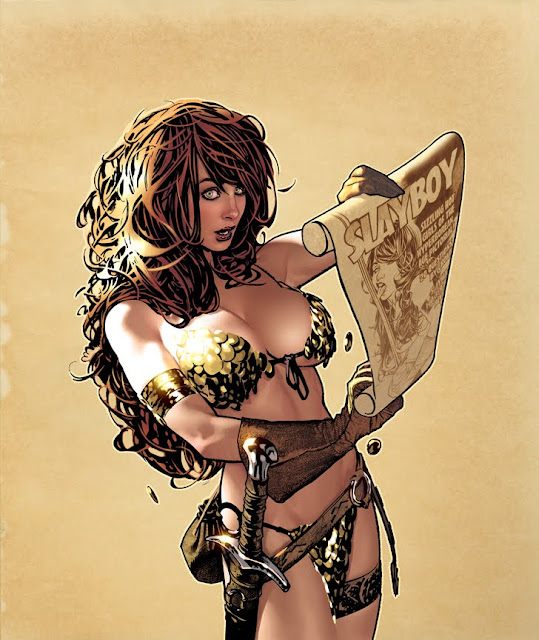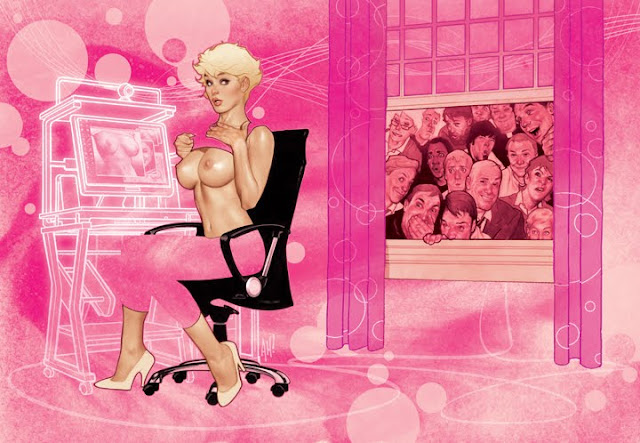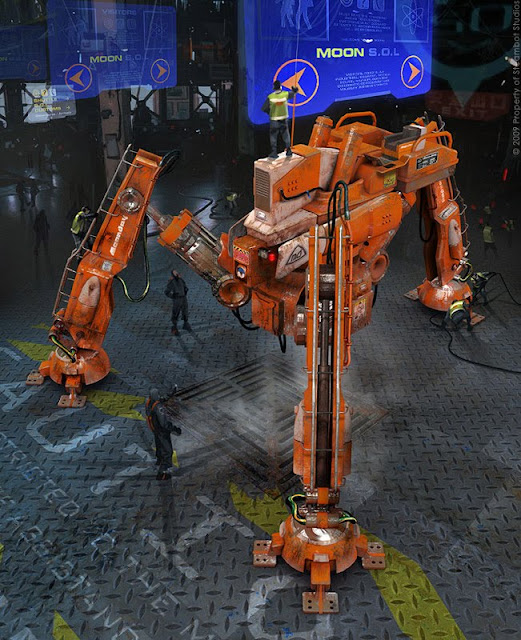I regret I've never done a feature on Adam Hughes. You do know Adam Hughes, right? The guy who did all the Catwoman, Wonder Woman, Starwars, Danger Girl, Power Girl pinups? I figured it's time to do one. Sort of.
Y'see, I stumbled upon this ol' post at The Drawing Board forums. It's a fairly old interview with Adam Hughes his coloring technique, from his Yahoo group. I can't be too sure if his technique has changed much throughout the years, but I figured it would make a good read for the time being:
Q: What version of Photoshop do you have?
Adam Hughes A: I'm still using Photoshop 5.0, because every time a new version comes out, yes they have exciting new features, but they also seem to like re-assigning keyboard shortcuts, which I LIVE for. I've got my key board shortcuts so memorized, it's like I'm playing the piano. If I switched now, the learning curve would slow me down.
Q: What are the main tools that you use in Photoshop?
A: The Lasso Tool, the Magic Wand, the Path Tool. I do a lot of my rendering with the Lasso Tool. I select an area, then fill it with 10% of the FG color. Then I move the selection (or make a new one) a little to the left or right, and do it again. Do THAT 6 times, and you've got a nice analogous gradation.
Sometimes I'll make Lasso selections with the feathering set up to give me a soft edge. Lara's Gerber-baby cheeks in the TR piece was done that way.
I also use Lighten and Darken (regardless of the tool) a lot when applying color.
Q: Do you keep a (color) palette next to you?
A: Definitely. I keep a lot of my Preference windows up while I'm working. The Palette is VERY important to me.
Q: What general sequence (if any) you use to color with Photoshop? (Such as) scanning inked artwork. Do you save a copy with lower dpi for easier coloring?
A: I color at print size. I upgraded my PC to handle a regular-sized comic cover with relative ease. I SHOULD upgrade again, now that you mention it…
Q: Is your local color midway between the item's shadow and highlight, or more towards its shadow…?
A: Darker. I treat the flatted piece as an imprematura, upon which I go in with my 'opaque' colors.
Q: (Do you) render the shadow areas with cuts and the airbrush & paintbrush tools?
A: Render light areas after. I never use the airbrush (or paintbrush) tool. It's got that phony digital softness I can't stand.
Q: Since you say you don’t use the paintbrush or the airbrush then do you smudge a lot?
A: No. I think the smudge effect looks digital and phony. I'll post a file with a detail from WW's face so you can see what I do up close. I let the printing and the reader's eye do a lot of the final 'closure' for me. My selections look like tiles in oil or gouache painting, when seen up close.
Q: Do you use different layers or channels for rendering? Do you render certain elements first, such as skin before moving on to hair, or foreground elements first before background? Do you render certain elements completely - shadows & highlights - before moving on to other elements? Do you render from shadow to light or vise-versa?
A: It's a judgment call. Whatever the piece calls for is how I handle it. I usually only have two layers going at a time. The basic background Layer, and them the section I'm working on (i.e.; WW's face) I save the selection of that area as a channel, that way I can get as sloppy as I want, and then I just load the inverted selection, delete the unwanted crap, and merge the layer back down to the base BG Layer.
Q: How do you go about changing the black line work in some of your pieces in Photoshop? (For example the trees in the background of the Hammer of the Gods cover). The closest I can get is choosing "Load Selection" and using the airbrush to color the inverted selection. But there always seems to be some color that creeps outside of the selected area regardless of how tight the selected area is. Please tell me there is an easier way?
 A: By 'creeps out of the selected areas' do you mean that unselected areas (non-line art) are getting colored? If that's true, then something's up with the feathering on your selection. If you mean, areas of your line art that you don't want to be colored are getting color, either de-select what you don't want to receive with the Lasso tool or don't use the airbrush tool.
A: By 'creeps out of the selected areas' do you mean that unselected areas (non-line art) are getting colored? If that's true, then something's up with the feathering on your selection. If you mean, areas of your line art that you don't want to be colored are getting color, either de-select what you don't want to receive with the Lasso tool or don't use the airbrush tool.When I want to change line art to color, here's what I usually do:
1. Load selection.
2. Invert the selection
3. Deselect everything but what I want with the Lasso Tool.
4. Activate the Line art Channel and delete the selected areas.
5. Leaving the selection going, I activate the CMYK channel, and Fill with whatever color I want.
This is for a PC, which is what I use. Macs have the ability to eliminate a step, and I can't figure out if it's a setting I can change in Photoshop, or it's just something that Macs do. On a Mac, you can make a Lasso selection in the Line art Channel, and it automatically 'grabs' just the black line art info.
Q: How do you do those amazing shines?
A: I do a large feather selection, then fill with a light color like a yellow or orange, set on Lighten. I do this to 'set the stage' as it were. Then I fill it again with a color like orange or red, set on Color Dodge. I then use the Fade filter to control how much the highlight 'burns'. Try it; it's fun to experiment!
Q: What do you use the Path tool for?
A: If I need to make a large gradeful color selection, such as might be found on a reflection on her armor, or on a leg or something, I'll use the Path tool to create a very graceful arc to my selection. It's also good for rendering color highlights on hair.
Q: The Lighten feature doesn’t seem to do anything when I use it?!?
A: The color you're applying (i.e., your Foreground color) has to be lighter than the areas you're trying to affect. It won't affect any areas that are lighter than your FG color. For example: a 50% magenta in your FG color selector, with your desired Tool set on 'Lighten' will only affect pixels that are 51% magenta or darker. Anything 49% or lighter won't be affected. It sounds confusing, but I stumbled upon it all by accident. I use it a LOT.

Q: How do you use the Fade filter?
A: The Fade Filter is at the top of the Filters drop-menu; it's the second from the top. On a PC, it can be keyboarded by hitting Ctrl + Shift + F. You'll also notice you can alter your color application there, after-the-fact. This is where I discoverd the value of Lighten, Darken, and Color Dodge. In the Fade Filter, you can change the color application of the function you just completed. It's a great 'before and after' tool.
Q: Do you use any Photoshop filters in order to give your colors a particular finish?
A: I never used to, but I've gotten braver about it. Sometimes when I feel my flesh values are too high-key, I run them through the Auto Levels filter, just to see what it does to them. Sometimes I use the result, sometimes I don't.
Q: What filters do you use commonly? What would you recommend for specific effects, such as metal gleam or rain?
A: I disdain the use of filters, until you can prove you can render that stuff on your own. It's like Ian Malcolm's diatribe against raising dinosaurs with genetic engineering in Jurassic Park. If you don't take the time to master a technique, you don't learn the even more important disciplines that come with the experiences. Any decisions you make with shortcuts are uninformed ones, and you open yourself up to a world of bad judgments.
And that ends this wonderful interview with Adam Hughes, brought to you by Adam Hughes Yahoo Group. Find it and join it if you like. Oh, and before I close this one out, I stumbled upon another post about good ol' Ah! at this comic blog. It's a bunch of Marvel beauties in swimsuits. I think it was done in the early-to-mid 90's... Here we have Black Widow, the Wasp and if you're into it, She-Hulk as well...
And that's that!!
Do you like animation? Do you dream of making your own animated short or showreel, that could rival professional studios? Then you've gotta hit the books. Or you could enroll at Les Gobelin...
This particular French "visual communication" school caught my eye after I featured one of their amazing alumni turned world-renowned concept artist in another post. Here's a sampler of what students are churning out at the academy. This is an opener to some festival several years ago:
You can check out their website at http://www.gobelins.fr/index-flash.htm. If you don't speak French, then maybe this promotional video can help you out:
It features good ol' Eric Riewer (who?) describing the school's various program and the selection process for new students, as well as what makes a good student film. Fascinating stuff, and it could help if you really do plan to enroll!
With that out of the way, lets watch some student shorts! Now I know the very mention of the word 'students short' might suggest weird, highly experimental, and amateurish pieces, but I assure you... their work is amazing. If you've seen some of the embedded films in my last post about that alumni-turned-concept-artist feerik, then you might know what to expect.
The first entry is a simple film called "Sébastien". A story about paper airplanes, and some deeper message about doing what you love.
Next, is Fenrir. Presented in the International Festival of the Film d' Animation (FIFA) d' Annecy 2009. By Nuno Alves Rodrigues, Usama Bouacheria, Alice Dieudonné, Aymeric Kevin, Ulysses Malassagne. It's about this a Fenrir that is awakened by the rays of the sun. The fenrir climbs this ancient tree Yggdrasil to attack the sun and some kid stops it. Or something like that.
Next is a film by Lucrèce Andreae, Julien Chheng, Tracy Nowocien, Rémy Schaepman, students of the formation Design and realization of films d' animation (2nd year) called Dodudindon. Something about letting loose.
And here is a favorite by some 2nd year students called Monstera Deliciosa. A film that celebrated the year 2009 through references to l'Allemagne or through "dance". Someone help me out here.
And now for something different. Jelly Sunday, which features little Gretchen her new friend “Jelly”.
Well. When are you going to send your application!?!?
He's French, he likes the hip-hop culture, and his art kind of objectifies women. His day job at Steambot Studios has him working on the most interesting franchises out there. He's Joel Dos Reis Viegas.
He studied at prestigious Les Gobelins, an experience he describes as "...something unique for anyone who wants to be an talented artist". He said it's known as one of the best animation schools in the world.
Well, guess what happens when someone who has a background in animation enters the concept art world. Yep. His drawings are full of beautiful gestures and powerful emotions!!!!
He uses all kinds of apps, like Artrage for color blending, Painter for those large, painterly strokes, and Photoshop for everything else. He also has above average 3D skills (which greatly complement his work), thanks to the wonderfully intuitive Mudbox. What a guy.
Of course, he wouldn't be where he is if he didn't develop discipline. It's said he worked as in-between animator and storyboarder for an Animation studio in Paris called Alphanim. Very interesting!
According to an interview at CG Channel, one of the most important skills an artist can learn is to control one's creativity, as a flow, and to be productive even when inspiration goes up and down. That's discipline for ya'!
"I have a fascination for explosive and controversial characters and I love to paint these. It could be a punk, monster, warrior or serial killer; I‘ll try to paint with the most appealing rendering possible" The guy never runs out of inspiration. Deform reality, observe, and all that jazz.
"...Hip hop is my culture, I grew up listening to rap music and looking at graffiti. It still influences my art. Sci-fi is everywhere, all the concept artists I know already painted sci-fi in the past, so I thought mixing both universes could make something interesting." That quote, my dear readers, was directly lifted from CG Channel.
His advice to all you wannabes and amateurs. A little something he learned from all those conferences and setting up his own lil' studio with a couple of concept art heavyweights: "Teamwork is the key when you start a structure with your friends. Its important to be able to see their skills and to learn from them."
"The other advice is be respectful with your friends, don’t think because you are friends you can be less organized or use less clear communication. You should treat each other like colleagues to keep good working relations. This is the key to succeed in creating together."
Interested? You might be. So go rummage through the archive through his blog (doesn't get updated often), or better yet, his deviantART.
Oh, and just so you're aware of what other graduates of this "Les Gobelin" churns out, why don't you watch some of these animated shorts?
Voodoo. Exquisite animation. It is what it is!
The classic Pyrats, which I featured already once in this blog. I didn't know it was animated by grads from this school. Took seven months, and was shown on an animation festival in 2006. Still awesome.
Traintamarre. Great mood. You may have not noticed, but I love 2D animation.
"Dan LuVisi is a digital concept artist working in the film, video game and comic book industry."
Okay just so I have something to say for this post, according to Mr. Dan "Adonihs" LuVisi's' lil' deviantART FAQ, he first started out real terrible-like. He said he could draw, sure, but the moment the pen touched the tablet...it was just one of the most irritating processes ever. "I felt like giving up, I found myself not know how to choose colors or do anything." As you can see, he eventually got the hang of it.
Nowadays, he usually works on a canvas roughly around 4500 x 6500 pixels (300 DPI = poster size) with tons of layers. It takes... three to four days to complete a piece.
Most of his skill was derived from the great tutorials at www.thegnomonworkshop.com. He did NOT attend art school. But I think you knew that.
He loves all the classic sci-fi movies including the original Star Wars trilogy, Blade Runner, Alien and Aliens, and so and and so forth.
To Mr. LuVisi, art is important in his life because people can remember him for that. You can follow him at his twitter account, or simply check out his extremely popular deviantART account from time to time.
































